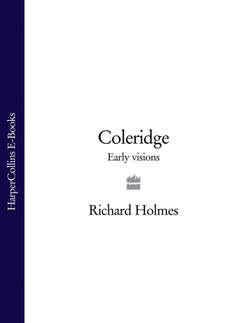Читать книгу Coleridge: Early Visions - Richard Holmes - Страница 38
5
ОглавлениеSouthey never met them as arranged, on the return leg through Aberystwyth; and Hucks had had enough by the time they reached Llandovery on 2 August. So Coleridge pushed on southwards alone, catching his first glimpse of Tintern, and then hastily crossing by the Chepstow ferry to Bristol, where he arrived on 5 August, sending a note round to his “fellow Citizen”, Robert Lovell.23 Southey was agreeably surprised by Coleridge’s “unexpected arrival”, and spent the next ten days introducing him to his circle of friends in the city.24
News of Pantisocracy quickly spread through Bristol, where Southey, Lovell and Coleridge (two Oxons and one Cantab) were regarded as the three moving spirits of the enterprise. Coleridge met Joseph Cottle, a young Unitarian publisher who was already printing Southey’s Joan of Arc, and who immediately offered to publish anything by Coleridge. “I instantly descried his intellectual character,” wrote Cottle, “exhibiting as he did, an eye, a brow, and a forehead, indicative of commanding genius. Interviews succeeded and these increased the impression of respect.”25 Cottle gained the impression, from the fervour of the three, that they were considering taking ship for America from Bristol at any moment, and considered it as a noble but “epidemic delusion”. This was an important introduction, and Cottle would become Coleridge’s first publisher in 1796.
Southey and Lovell also introduced Coleridge to the Fricker family. They were a household of five, high-spirited, dashing girls, whose widowed mother kept a dress shop in Bristol. (There was also a son, George Fricker, who was always getting into scrapes.) Robert Lovell had just married the second daughter, Mary, who had worked as an actress; and Southey was courting the third, Edith, who was generally regarded as the sweetest-natured of the Frickers, and who worked as a milliner.
Of the remaining two of marriageable age (little Eliza was still a schoolgirl), Sara Fricker, the eldest then twenty-four, was thought to be the most handsome and hot-tempered; and Martha Fricker the most wayward and amusing. Among the Pantisocrats, George Burnett – then living in Somerset – had expressed interest in Martha, and would propose to her later that autumn. (She turned him down.) By simple mathematics, that left Sara and Coleridge, though temperamentally they were the most wildly unsuited of the couples.
Under normal circumstances it would be difficult to imagine anything more than a brief, summer holiday flirtation taking place. But circumstances were not normal, for several reasons. In the first place, the entire Fricker family was also caught up in the Pantisocratic whirlwind, and as Coleridge later observed mournfully, it was easy to mistake “the ebullience of schematism for affection, which a moment’s reflection might have told me, is not a plant of so mushroom a growth”.26
In the second place, Coleridge’s encounter with Mary Evans at Wrexham had reminded him how avidly he craved affection, and of the lost joys of the Evans family household. The Fricker family seemed to offer an instant and almost miraculous substitute. He was – in the old phrase, which seems particularly suited to Coleridge – on the rebound, and feeling increasingly isolated from his own people at Ottery. Moreover, Southey was now aware of this volatility, as later events that autumn showed. He felt a moral duty to help Coleridge put his emotions in proper order. An alliance with Sara seemed the logical answer, which fitted so beautifully into all their plans.
Southey’s own position was curiously ambiguous. There is evidence that his own attentions had first been paid to Sara until, finding her too demanding, he had turned to the more docile Edith.27 He always retained great fondness for Sara (as life at Keswick later showed), and there may well have been some element of soothing his own guilty conscience in the brotherly rigour with which he soon pressed her suit with Coleridge.
Finally, there can be little doubt that there was considerable sexual attraction on both sides. Coleridge was generally acknowledged as the most brilliant of the Pantisocrats, a Cambridge scholar with a possibly dazzling future, which greatly appealed to the high-strung and ambitious Sara, who loved his jokes, his dark hair, and large wild eyes. While Coleridge, always susceptible to female beauty, must easily have fallen for Sara’s bright animated face, her bubbling ringlets of brown hair, her quick teasing wit and generous, carefully laced figure turned out in the latest dress-shop fashions.
